Flies
Of the thousands of species of flies, only a few are common pests in and around the home. Some of the more common nuisance flies are the house fly, the fruit flies, the drain flies, the face fly, the stable fly, the little house fly, and several species of garbage fly. These pests breed in animal wastes and decaying organic material from which they can pick up bacteria and viruses that may cause human diseases. In addition, adult stable flies (sometimes called “biting flies”) feed on mammalian blood and can give a painful bite.
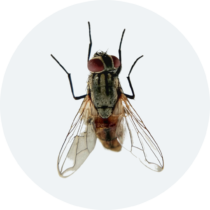
The female fly deposits her eggs in animal waste or moist organic material where the larvae, or “maggots,” complete their development, feeding on bacteria associated with their developmental site. Once the female fly has mated, she can lay several batches of eggs, typically containing over 100 eggs each.
While humans commonly find adult flies to be the most bothersome, the larval stage should be the prime target for control efforts. Elimination of larval habitat is the preferred method of pest fly suppression. By removing material in which the larvae develop, the life cycle of the fly can be broken, preventing subsequent production of adult flies. While chemical pesticides may be effective for suppressing adult fly populations in some situations, they are not a substitute for proper sanitation and aggressive elimination of nuisance fly developmental sites. Because flies can quickly develop resistance to insecticides, use them only as a last resort to obtain immediate control of adult flies.
Types of Flies
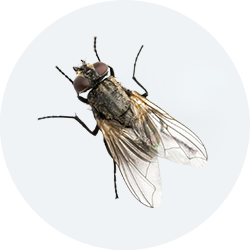
Characteristics: Black or gray; clear wings, bulgy eyes.
Legs: 6
Antennae: Yes
Wings: Yes
Habits:
- Similar to deer flies; do not breed inside structures.
- Bites can be very painful resulting in visible wounds.
- Significant livestock pests with their painful and persistent biting behavior.
Habitat
In rural areas, manure piles are often the main source of house flies, and in urban areas, piles of fermenting lawn clippings commonly generate large numbers of flies. Animal manure is a favorite breeding medium for flies with the most important sites being horse manure, human excrement, cow manure, fermenting vegetable refuse, dumpsters and refuse containers, and household garbage. Some species of flies can live and breed in recycling containers, and fly problems are common in recycling centres
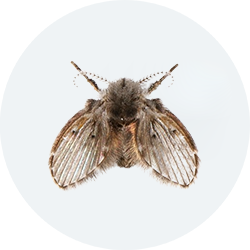
Characteristics: Small; short, hairy bodies and wings, giving them a furry appearance.
Legs: 6
Antennae: Yes
Wings: Yes
Habits:
- May appear suddenly from sinks and bathtub drains.
- Get their name from the fact that they often breed in drains.
- Being tiny flies, they can easily crawl through normal fly screens.
Habitat
Drain flies develop in muck or gelatinous material that accumulates in sewage disposal beds, septic tanks, moist compost, or dirty garbage containers. They may also emerge from drains of sinks or bathtubs, from tree holes, rain barrels, moist organic solids, or bird nests that have accumulations of fecal material. Drain flies gather, mate, and lay eggs in moisture or standing water. The slimy film that forms in sewers and drains is a favorite breeding spot. Inside structures, they are strongly attracted to light and will be found on glass windows, doors, lamps, and indoor lighting.
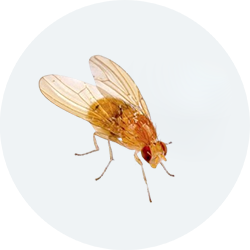
Characteristics: Oval, yellow to pale brown, often with bright red eyes.
Legs: 6
Antennae: Yes
Wings: Yes
Habits:
- Attracted to overripe fermenting fruit and vegetables.
- Capable of transferring E.coli, Salmonella, and Listeria from one surface to another.
- Larvae, or maggots, feed on overripe fruit and may spread yeasts that cause souring.
Habitat
Fruit flies are small flies that can pass through ordinary insect screens and are often found in homes, restaurants, fruit markets, bars, salad bars, and any other place where fruits and vegetables are found. They will often enter structures from nearby dumpsters, trash receptacles, and damp compost piles where fruits and vegetables have been disposed of. Fruit flies lay large numbers of eggs on fruit, and the hatched larvae feed on the fruit. Fruit flies are active during periods of warm weather; single generations may develop in less than a week when temperatures are between 80° and 89°F.
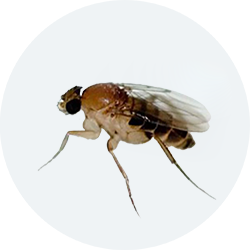
Characteristics: Usually black or dull brown, but sometimes yellowish in color
Legs: 6
Antennae: Yes
Wings: Yes
Habits:
- Attracted to overripe fermenting fruit and vegetables.
- Phorid flies eat a variety of decaying matter, especially organic material that gathers in drains or other plumbing. This includes decomposing food, fungi, and insects.
- Larvae, or maggots, feed on rotting left over food.
Habitat
Phorid flies breed wherever moisture exists, so they’re often found around plumbing and drains in rooms like bathrooms and kitchens. They can also be spotted in garbage containers, crawl spaces, and basements. Adult phorid flies are most active during the warmer months of the year, but can still be found during the winter months.
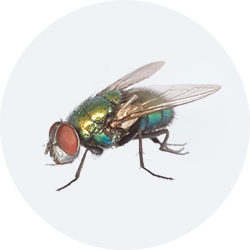
Characteristics: Metallic; blue, green, gold to shiny black
Legs: 6
Antennae: Yes
Wings: Yes
Habitat: Prefer hot, humid weather and gravitate toward decomposing matter.
Habits:
- Distinguished by their bright metallic appearance.
- Adults lay eggs on the carcasses of dead animals.
- Responsible for carrying the bacteria that can cause dysentery, typhus, and cholera.


